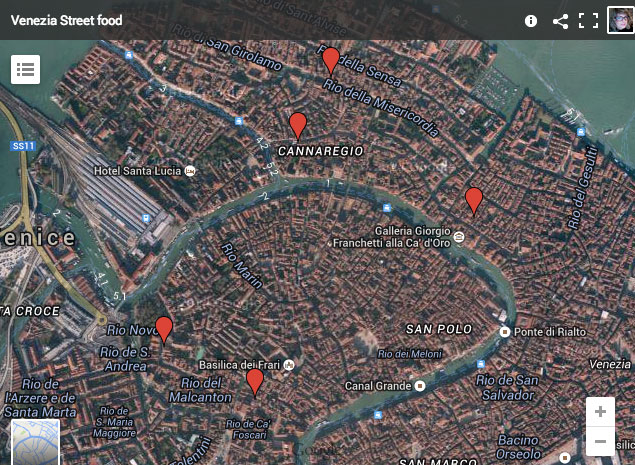Street Food in Venice: where to eat the best meatball,the best fried food in a paper cone, the best sandwich and the best fritter.
Today we’ll start a new section that will be enriched by your suggestions. The attention is focused on all those dishes, cicchietti, sweets, and food in general, you should try at least once in a lifetime if you come to Venice. We are talking about both street food, cheap but delicious and tasty, and simple delicacies to eat while sitting in the local pubs and restaurants, in every case with a more than reasonable price.
Let’s start with the aperitif, small and big appetizers and sweets.
All the venues below are located in areas very close to Piazzale Roma and Santa Lucia train station so are easily reachable on foot.
WHERE TO DRINK THE SPRITZ
Choose a place to drink a spritz or aperitif in Venice is not easy but among all we suggest the Osteria al Timon in Fondamenta degli Ormesini. In addition to a wide selection of wines by glass and a really good spritz , a variety of unique appetizers suitable for everyone, what is most striking is certainly the possibility drink and eating sitted in one of the three boats stationed in front of the Osteria.
WHERE TO EAT THE BEST MEATBALLS OF THE UNIVERSE
At least once in life you must try one of the meatballs at Osteria alla Vedova, in Strada Nuova, just a few steps from Ca ‘d’Oro. The venue is the classic bacaro that exudes definitely an atmosphere of old times, a few and very narrow seats, but most of the people prefears to stay in the street just outside the door quietly waiting for a meatball and a good glass of wine. What’s so special about these meatballs? They’re very crunchy, the consistency is absolutely perfect and the flavour definitely impassable.
WHERE TO EAT THE BEST FRIED FOOD IN A PAPER CONE
The Frito Inn is perfect for those who want to eat in a very small amount of time a big portion of fried fish or battered vegetables or chips, or an amazing mozzarella in carrozza. This venue where the food is eaten just standing is located in a small and characteristic square that’s just a short walk from the train station, near the market of Cannaregio, in Campo San Leonardo. The fried food is always done at the moment and is very digestible. The prices are very competitive: a paper cone full of fried fish costs just € 4.
WHERE TO EAT A FAST BUT TASTY SANDWICH
The Bacareto di Lele has been since ages a must place for all those who live in Venice as both students and tourists. Is just at 300m from Piazzale Roma in a typical Campiello, before the Church of San Nicolò dei Tolentini. The small sandwiches with cold cuts of all kinds are absolutely irresistible, always fresh, fragrant and appetizing, and at an unbeatable price: € 1 each. To taste with the classical shadow(glass) of wine.
WHERE TO EAT THE PERFECT FRITTER
The fritter is the classic Venetian sweet that all the bakeries produce during Carnival. The fritters are not all of the same kind. Those absolutely perfect, classic Venetian without stuffing with raisins and pine nuts, soft, fragrant, that melt in your mouth, can be eaten at the pastry shop Tonolo in Calle Crosera. Not to be outdone the cream or zabaglione ones. Tonolo is a very popular pastry, with all kind of desserts strictly of their own production, and is just a short walk from Piazzale Roma.
Below you will find a map with all the locals that we talked about marked as to reach them more easily.

